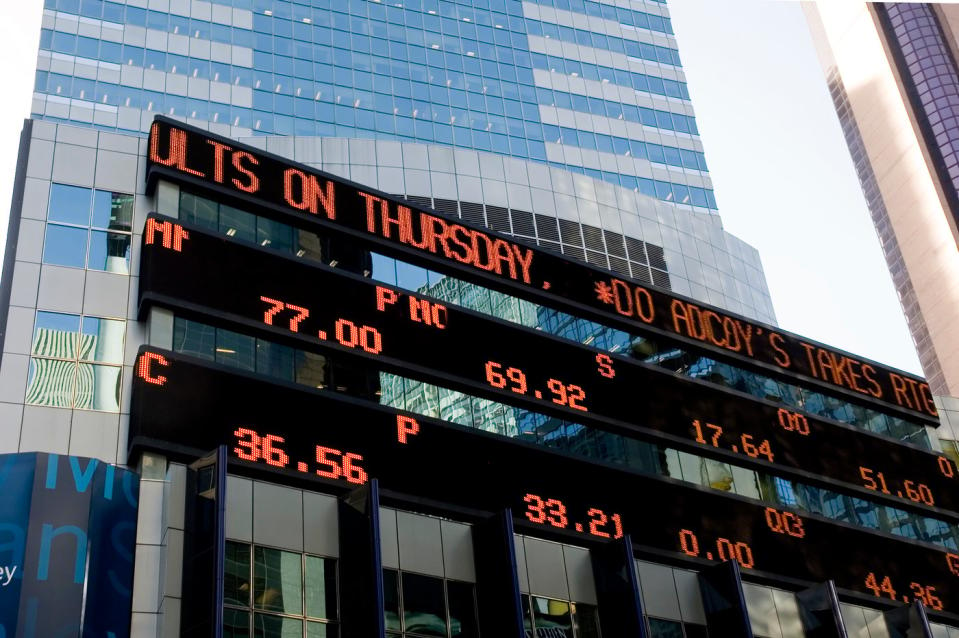For more than 128 years, the Dow Jones Industrial Average (DJINDICES: ^DJI) has served as Wall Street’s most prominent barometer of the stock market’s health.
When it debuted on May 26, 1896, it was comprised of 12 mostly industrial companies. Today, the Dow Jones is a melting pot of 30 time-tested, multinational businesses from an assortment of sectors and industries.

However, the Dow has one major difference/glaring flaw when compared to Wall Street’s other major stock indexes, the S&P 500 and Nasdaq Composite. Whereas the point values of the latter two indexes are determined by market-cap weighting, the Dow’s value is derived entirely from share-price weighting. In other words, the higher a publicly traded company’s share price, the more influence it has within this ageless index.
For example, Walmart is a $620 billion company, as of this writing, and the fourth-largest Dow component by market cap. But its $77 share price is only 25th in the pecking order among the Dow’s 30 constituents. The second-smallest component by market cap ($53 billion), insurer Travelers Companies, exerts three times the influence of Walmart with its share price of roughly $231.
When Dow stocks underperform over lengthy periods, or their share price becomes too low, they’re often at risk of getting kicked out of this iconic index. Semiconductor stalwart Intel (NASDAQ: INTC), whose share price has fallen below $20, is very likely going to be shown the door sooner rather than later. The surprise is that artificial intelligence (AI) kingpin Nvidia (NASDAQ: NVDA) may not be the slam-dunk replacement you’d think it would be.
Intel’s time in the Dow may be coming to a close
Central processing unit (CPU) Goliath Intel was added to the Dow Jones Industrial Average on Nov. 1, 1999. On a nominal basis (i.e., excluding dividend payments), shares are down 49% since this addition. But even with dividends included in its returns, shares have fallen by 7% in almost a quarter of a century.
S&P Dow Jones Indices, which is the body that decides which companies enter and exit this widely followed index, can’t be pleased with Intel’s performance or its now-microscopic influence.
Intel’s problems are threefold. First, it fell behind the innovative curve and allowed Nvidia’s graphics processing units (GPUs) to become the undisputed top choice in AI-accelerated data centers. Even with Intel unveiling its Gaudi 3 AI-accelerating chip in April of this year, it’s painfully evident that the company missed its early-stage sales opportunity.
Second, the company is building out its foundry-services segment from scratch. This includes two chip-fabrication plants in Ohio, as well as another in Germany. Despite its ambitions to become the world’s No. 2 foundry by 2030, getting the infrastructure in place to make this happen is exceptionally costly and is weighing heavily on the company’s bottom line.
The third issue for Intel is that Advanced Micro Devices (NASDAQ: AMD) has been (pardon the necessary pun) chipping away at its moat in legacy CPUs for personal computers and data centers. Even though Intel has retained the lion’s share of the CPU market for PCs, ceding any share to AMD means giving up precious operating cash flow at a time when its foundry segment is losing money hand over fist.
Although I believe the puzzle pieces are in place for Intel to execute a turnaround — albeit one that takes multiple years to take shape — its days in the Dow appear numbered.
Should Nvidia replace Intel in the Dow? Not so fast…
Following Nvidia’s historic 10-for-1 stock split in June, which decreased its nominal share price from north of $1,000 to $106, as of this writing, it would only be logical for Wall Street’s chip leader and AI darling to take Intel’s place in the Dow.
In each of the last two years, Nvidia’s hardware accounted for roughly 98% of the GPUs shipped to data centers, according to TechInsights. Nvidia’s H100 GPU and successor Blackwell chip, which is expected to begin shipping during the first quarter of 2025, shouldn’t have any trouble maintaining their computing advantage over external competitors, which include Intel’s Gaudi 3 and AMD’s MI300X.
What’s more, Nvidia’s CUDA software platform is helping to keep businesses hooked on its hardware. CUDA is the toolkit developers use to build large language models (LLMs) and get the most out of their Nvidia AI-GPUs.
But in spite of Nvidia’s dominance in AI, S&P Dow Jones Indices may be leery about handing over the keys to this AI juggernaut.
To start with, the Dow is traditionally comprised of time-tested companies. While this doesn’t mean growth stocks aren’t allowed in the index, it does mean S&P Dow Jones Indices generally avoids adding companies that are solely inflated in value because of the latest next-big-thing trend on Wall Street.
Over the last 30 years, there hasn’t been a single next-big-thing innovation, technology, or trend that’s avoided an early-innings, bubble-bursting event. This is to say that investors regularly overestimate how quickly a new technology or trend will be adopted by consumers and businesses.
We’re likely witnessing this same story play out with artificial intelligence. The simple fact that most businesses lack clearly defined blueprints as to how they’re going to monetize AI all but confirms that we’re in the early stages of a bubble-bursting event. S&P Dow Jones Indices is probably reluctant to add Nvidia for fear of an AI bubble taking shape.
Although it’s a bit of a nitpick, the second issue is that Nvidia’s 10-for-1 split may have pushed its share price down too far for consideration in the Dow. Ideally, a $2.6 trillion company should have meaningful influence within the 128-year-old index. However, its $106 share price would rank it 23rd among the 30 components.


If Intel gets the boot, this company is the best-suited replacement
Assuming Intel’s low share price gets it axed from the Dow in the not-too-distant future, the smartest addition wouldn’t be Nvidia. Instead, networking-solutions specialist Broadcom (NASDAQ: AVGO) would make for a more-encompassing add to this iconic index.
Similar to Nvidia, Broadcom recently completed a 10-for-1 forward-stock split, which reduced its share price from well over $1,500 to a more nominally appealing $154, as of this writing. This would rank Broadcom 20th in order of highest-to-lowest share price within the Dow.
More importantly, while Broadcom has, undeniably, benefited from the AI revolution, its sales channels are considerably more diverse than Nvidia.
Over the last year, Broadcom’s AI networking solutions have garnered a lot of buzz. These solutions are being counted on to reduce tail latency in AI-accelerated data centers, as well as maximize the computing potential of AI-GPUs. But there’s so much more to Broadcom than just AI.
It’s one of the world’s leading providers of wireless chips and accessories used in smartphones. While some aspects of the 5G revolution have been underwhelming, a steady device-replacement cycle for consumers and businesses wanting to take advantage of faster download speeds has been a clear benefit to Broadcom and its order backlog.
Broadcom also provides an assortment of optical products and networking components to the industrial sector and automotive industry, in addition to having an ingrained role in data-center networking solutions.
Furthermore, it hasn’t been afraid to use acquisitions as a way to expand its product and service ecosystem, or to promote cross-selling opportunities. The purchase of Symantec in 2019 gave it a powerful presence in cybersecurity solutions. Meanwhile, its $69 billion buyout of VMware last November positions Broadcom to be a key private- and hybrid-cloud solutions provider for businesses.
If Intel gets the boot from the Dow Jones Industrial Average, Broadcom may be the best direct replacement.
Should you invest $1,000 in Intel right now?
Before you buy stock in Intel, consider this:
The Motley Fool Stock Advisor analyst team just identified what they believe are the 10 best stocks for investors to buy now… and Intel wasn’t one of them. The 10 stocks that made the cut could produce monster returns in the coming years.
Consider when Nvidia made this list on April 15, 2005… if you invested $1,000 at the time of our recommendation, you’d have $656,938!*
Stock Advisor provides investors with an easy-to-follow blueprint for success, including guidance on building a portfolio, regular updates from analysts, and two new stock picks each month. The Stock Advisor service has more than quadrupled the return of S&P 500 since 2002*.
*Stock Advisor returns as of September 3, 2024
Sean Williams has positions in Intel. The Motley Fool has positions in and recommends Advanced Micro Devices, Nvidia, and Walmart. The Motley Fool recommends Broadcom and Intel and recommends the following options: short November 2024 $24 calls on Intel. The Motley Fool has a disclosure policy.
Intel Is Probably Getting Kicked Out of the Dow, but Nvidia May Not Be Its Logical Replacement was originally published by The Motley Fool
